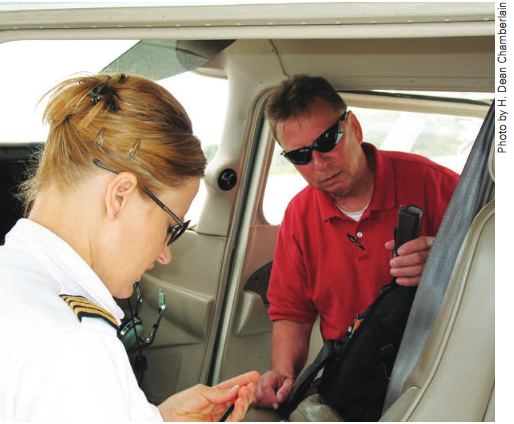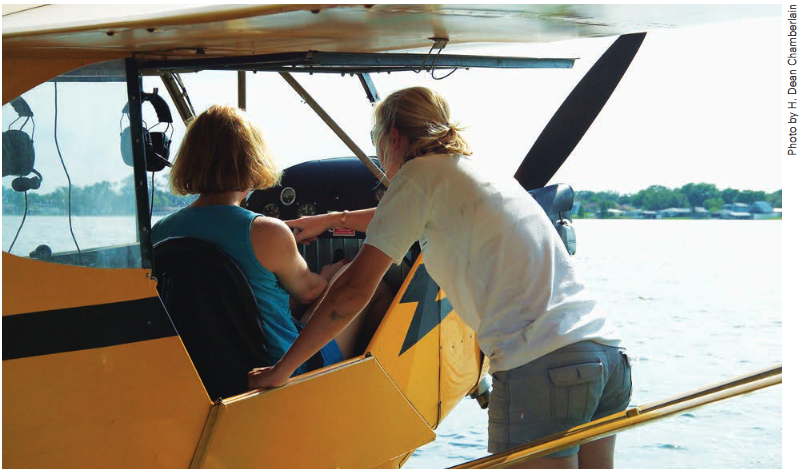Pathways to Pilothood
How to Get Your Flying Career Off the Ground
By Michael G. Gaffney
Source: FAA Saety Briefing, Sep/Oct2016
Face it: once you have the aviation bug, it becomes all you can think about. You look to the sky and it calls you, but just how do you get started among all the choices? When it comes to pathways to becoming a pilot, it is important to know what you want to do with that desire and to get some advice from people who know and understand the flight training industry. For one who wants to fly professionally in commercial aviation as a corporate or airline pilot, for example, the paths are tried and true. For someone who just wants the freedom of flying for pleasure or business, the pathway has more choices. Let’s explore some options!

Possible Pathways
While some of the finest aviation training in the world comes from the United States military, the number of slots available to candidates is very limited. For those who can get accepted — congratulations. For the rest of us civilians, there are a number of well-blazed paths to certification. These include independent flight instructors, flying clubs or airport flight schools, flight training academies, and university flight programs. There are other avenues available, but we’ll confine this discussion to the most common ones.
An important note: the most structured paths are also going to be the highest-priced options. That said, many high school students since the 1950s have chosen to attend universities with flight training programs and found them to be excellent from both an educational as well as a quality of training perspective. Many flagship aviation programs offer excellent programs that allow students to earn Associates, Bachelors, Masters, and even a PhD in aeronautical areas while earning flight certifications. Having these
credentials does not guarantee faster employment, but it does offer more options. Many airline and corporate flight department heads have graduated from these programs and have been given the option to stay flight current while carrying the responsibility (and the pay) of the manager or director. In addition, if the student earns a degree in safety, engineering, or airport management, it can open many other career options, including working for the FAA.
Evaluating Traditional Training Paths
Traditional civilian programs in the United States typically use the terms “part 141” or “part 61” (referring to the aviation certification portions of Title 14 of the Code of Federal Regulations (14 CFR), which govern U.S. pilot certification. A “part 141” school uses a specific curriculum and undergoes active oversight by the FAA, which ensures that all regulations and standards are being met. A “part 61” training program is one that uses certification regulations, but is not subject to active FAA supervision of its operations. There are some excellent part 61 schools in the country that are run in a very professional manner without being 14 CFR part 141 approved. While the part 61 path might work well for a pilot who desires to fly for pleasure or personal business, it is probably not the most efficient if the end goal is to fly professionally. Airlines and corporate flight departments are generally looking for a documented, disciplined approach to training that is more likely to come from a certified flight training school, university aviation program, or flight training academy using some form of part 141 FAA oversight, along with a regimented training approach that mirrors the standards found in
professional flight departments.
A frequent question is the difference between flight training schools and flight training academies. Flight training academies (such as CAE Oxford, FlightSafety, ATP, and American Flyers) are generally focused on producing career-focused pilots destined for the airlines. An academy typically trains uniformed cadets in batches and takes a high paced, high volume approach that is generally ill-suited for the casual flyer. A flight training school is more focused on individual certification achievements such as a private pilot certificate or adding an instrument rating. If this is your goal, then a flight training school is ideal. Some schools specialize in a particular kind of training using a syllabus tailored for that training, so it is important to pick the school whose emphasis matches your goals. For instance, some schools focus on glider or helicopter training, or may specialize in one particular brand of normal or light sport aircraft. Knowing what type of training a school emphasizes should be an important part of your selection criteria. If you have already selected a particular kind of aircraft, then finding a school that specializes in training with that aircraft is the ideal choice.
Flight training schools are plentiful in the United States and are generally found at airports surrounding most cities. My advice is to identify schools at airports that are not hubs for airline traffic. Airline traffic will always have priority over general aviation traffic, and the delays created by staying clear of arriving and departing airline traffic will definitely have an impact on training time and cost. In most metropolitan areas, there are designated primary and secondary airports, and most flight training
schools will locate themselves at the secondary airports just for this reason.

Flight and Ground Instructors
Hiring a flight instructor at an airport, or being assigned one at a flight training school, is how many of us learned to fly. It remains a viable path to certification, given time or budget constraints, but some caution is in order. While independent flight instructors may offer a cost effective solution on an hourly basis, they may not be the best solution over an extended certification program. All instructors in the United States are certified by the FAA using stringent certification standards, but not all instructors utilize “best in class” instructional techniques once in the field. Instructors who teach at reputable flight training institutions must pass ongoing competency and standardization checks, which ultimately assures that the student will get a more consistent training experience. As with doctors, lawyers, and engineers, there are groups that publish information about instructors who stand out as the most professional in their field. Both the National Association of Flight Instructors (NAFI) and the Society for Aviation and Flight Educators (SAFE) can provide information. There are also “Master Instructor” accreditation programs dedicated to accrediting flight and ground instructors who complete a grueling recertification program every two years. The bottom line is that you owe it to yourself to get the highest quality and safety minded training you can
find, so do your homework.
Interviewing Your School
You also need to do your homework on the training facility you choose. For starters, be sure to visit more than one flight school. Most schools offer some kind of “discovery flight” geared toward helping you make the decision to get started. Use this opportunity to look around and ask questions. Any training school worth its salt will be proud to tell you about the experience of its instructors, and tell you about how its safety reporting program works. There are other telltale signs of a quality operation: How clean are the aircraft? How organized are the briefing and training areas? Ask to see the maintenance hangar, and look for an organized and orderly work area. Do they use simulators and have formal ground schools? Can they show you the syllabus that will be used for your training? Do they give you ranges and factors to consider for completing your training on schedule and on budget? If any of the answers to these questions seem uncertain, then you should continue evaluating your options. Be aware that there are many variables (e.g., weather and aircraft maintenance) that can affect cost and schedule. Some schools may offer an attractively low price, but a little homework should tell you if the price quoted is too good to be true. Also remember that a pilot’s lifelong flying habits are often formed by first impressions in the learning process. You owe it to yourself to get the best foundation you can find in your area.
Parting Thoughts
In evaluating your paths to “pilothood,” focus on identifying your goals and selecting the school which will best achieve those goals by providing a structured program and standardized instructors that are trained to help accomplish your goals safely. Spend some time with your potential flight instructor to make sure your personalities and styles are compatible. The instructor must make it fun while keeping your training progressing along a defined syllabus. When in doubt, ask others.
Learning to fly should be one of the most exciting and exhilarating experiences of your life. A little research and prudent selection will make sure that it is.
Michael “Mike” Gaffney is an ATP pilot, Airframe and Powerplant Mechanic, and an experienced Chief Flight & Chief Ground Instructor with almost 3,800 flight hours. He was named the “National Flight Instructor of the Year” in 2007 and received the National Aviation Transportation Association (NATA) 2007 Flight Training Excellence Award. He is a 6-time Master Flight Instructor and Master Ground Instructor. |